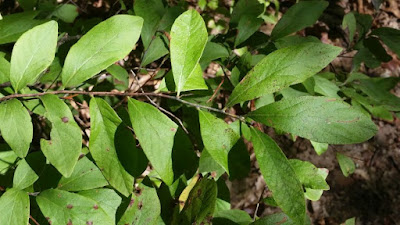A genus of bulbs that are part of the larger Amaryllis family. The funnel-shaped flowers appear late summer after the foliage dies down.
Plant the bulbs no more than 6 inches deep and 1 foot apart.
Most species are hardy from zones 7 to 9
* photos taken on March 28 2010 @ U.S. National Arboretum, D.C.


Lycoris aurea ( Golden Spider Lily )
A bulbous perennial, reaching up to 2 x 2 feet, that is a native to central & southern China, Japan and much of southeast Asia. It is found on moist, shaded slopes in the wild. The bulbs are up to 2 inches wide.
The leaves, up to 24 x 1 inches in size, appear during spring. The leaves are mid-green with a bright green midrib.
The golden-yellow flowers, up to 4 ( rarely over 3 ) inches across, appear during late summer.
Hardy zones 7 to 10
* photos taken on Aug 2011 in Columbia, MD

Lycoris chinensis ( Yellow Chinese Spider Lily )
A bulbous perennial, native from southeastern China to South Korea. The bulb is up to 1.5 inches wide. It is found on moist, shaded slopes in mixed forests in the wild.
The leaves are mid-green with a bright green midrib. The foliage appears during spring.
5 to 6 yellow flowers, up to 1 inch long, appear atop a cluster up to 2 feet high, during mid to late summer.
* photos taken @ Smithsonian Inst, Wash., DC on Aug 25 2014
Lycoris 'Hill Beyond Hill'
Flower scapes, up to 2 feet in height, bear spidery flowers that are yellow fading to creamy-white.
Hardy zones 7 to 10 ( possibly 6 )
Lycoris radiata ( Red Spider Lily )
A bulbous perennial, reaching up to 3.3 feet, that is native to Nepal, central & southern China, Korea and Japan. It is found on stream banks and moist shaded slopes in the wild. The bulbs are up to 1.2 inches wide.
The leaves are up to 18 x 0.3 inches in size. The deep green foliage appears during autumn.
The orange-red, spidery flowers, up to 2 inches across, appear during late summer.
Hardy zones 3 to 8 ( mulch heavily during winter in colder regions ).
* photo of unknown internet source
* photos taken on Sep 10 2023 @ Smithsonian Institute, Wash., DC
Lycoris sanguinea ( Orange Spider Lily )
A bulbous perennial, reaching up to 2 feet in height, that is native to China, Korea and Japan. It eventually spreads to form small colonies. It is usually found in woodland edge in mountainous areas.
The linear leaves, up to 24 x 0.5 inches in size, appear during spring then go dormant by early summer.
The orange-red flowers, up to 2.4 inches wide, appear during late summer. They appear on a stalk up to 2 feet high.
Hardy zones 6 to 9 ( 5b on protected sites ) in full sun to partial shade on moderately moist, humus-rich, fertile, well drained soil. The bulbs should be planted 9 inches apart with 0.25 inches of the bulb neck above ground.
Lycoris squamigera ( Resurrection Lily )
A fast spreading, bulbous perennial, reaching up to 3 x 2 feet, that is native to far eastern China, Korea and Japan. It is found on streambanks and moist shaded slopes in the wild.
The leaves are up to 12 x 2 inches in size. The foliage appears during autumn then again during early spring.
The fragrant, pale pink flowers, up to 4 inches across, are borne on large inflorescences during late summer.
Hardy north to zone 4 if summers are hot. It requires full sun to partial shade on moderately moist, humus-rich, well drained soil. It is drought tolerant during summer while the foliage is dormant. The bulbs should be planted 6 inches deep and 6 inches apart. Clumps do not like disturbance and may skip a year blooming if moved.
* photos taken on Mar 18 2017 @ Brookside Gardens, Wheaton, MD
* photo taken on Aug 11 2018 in Columbia, MD
* photo taken on July 27 2019 in Columbia, MD
* photos taken on Aug 13 2020 in Columbia, MD
* photos taken on Aug 4 2021 @ U.S. National Arboretum, Washington, DC
* photos taken on Aug 10 2021 in Columbia, MD
* photos taken on Aug 11 2022 in Columbia, MD
* photos taken on Aug 11 2023 in Columbia, MD
* photos taken on Aug 3 2024 in Columbia, MD

































































































